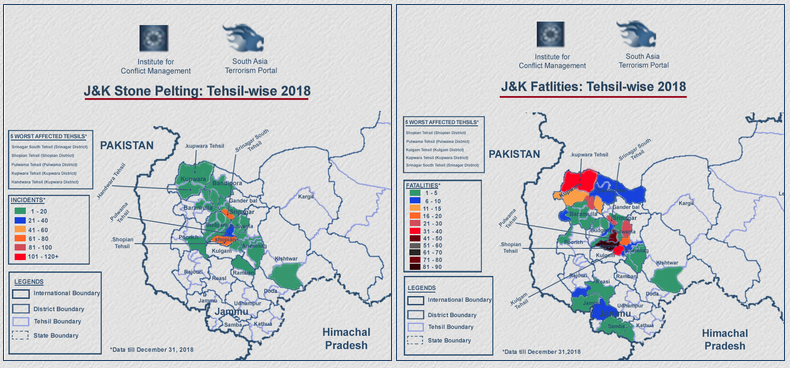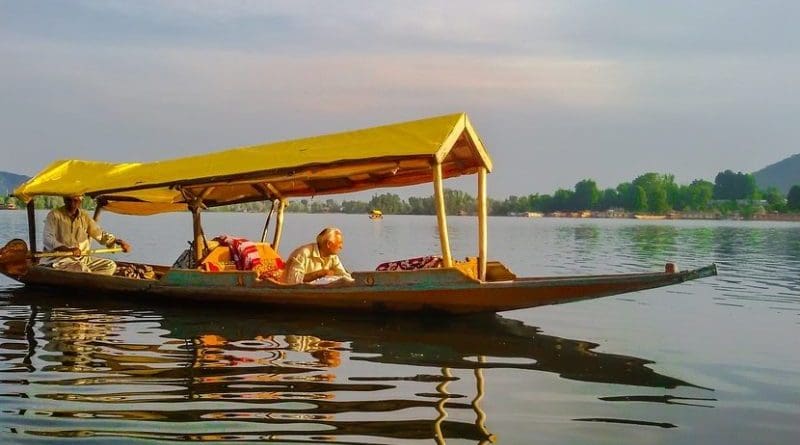India: Frittering Gains, Feeding Disruption In J&K – Analysis
By SATP
By Ajit Kumar Singh and Nijeesh N.*
The politics of opportunism as well as the political incongruity of the Bharatiya Janta Party (BJP)-led Central Government has enormously emboldened Pakistan’s Inter-Services Intelligence (ISI), the fountainhead of terrorism in Jammu and Kashmir (J&K), as well as its proxies in the State. Indeed, these forces have discovered renewed opportunities in the political mischief and policy vacuum that currently afflicts J&K, to push the State back towards the darkness of 1990s and early-2000s.
ISI-backed terrorism in J&K was widely considered to be on its last-legs by the end of 2012 and even after, though terrorism-linked fatalities increased gradually, even as intermittent and orchestrated street violence escalated. The continuous destabilization of the State, combined with the politics of polarization that has pitted the Muslim-dominated Valley against the Hindu-dominated Jammu region, has created spaces for a resurgence of terrorism over the past years, culminating in the February 14, 2019, Pulwama Vehicle Borne Improvised Explosive Device (VBIED) Attack which resulted in death of 40 Central Reserve Police Force (CRPF) personnel, the highest fatality figure for Security Forces (SFs) in a single attack since the commencement of the insurgency in 1988.
A VBIED attack in the state was last reported on November 2, 2005, when a suicide bomber blew up his car at Nowgam, near the private residence of, then Chief Minister Mufti Mohammad Sayeed, killing three policemen and six civilians. VBIED attacks, a devastating terror technique successfully used in Afghanistan by Pakistan-backed militants, have thus resurfaced in J&K after a hiatus of over 13 years, suggesting a potentially critical strategic shift resulting from the US’s announcement of its intention to withdraw its Forces from Afghanistan, a clear sign of US’s acceptance of its imminent defeat. The danger of an escalatory dynamic of terrorism in the State has clearly intensified.
According to partial data compiled by the South Asia Terrorism Portal (SATP), J&K has recorded a total of 74 fatalities, including two civilians, 43 Security Forces (SF) personnel, and 29 militants, in terrorism-related incidents in the current year, so far (data till February 17, 2019). During the corresponding period of 2018, the State recorded 34 fatalities (six civilians, 13 SF personnel, and 15 militants). The total number of fatalities through 2018 stood at 451 (86 civilians, 95 SF personnel, and 270 militants), significantly higher than the 2017 figures, with a total of 358 fatalities (57 civilians, 83 SF personnel, and 218 militants). 267 fatalities (14 civilians, 88 SF personnel, and 165 militants) were recorded in 2016. Indeed, year-on-year fatalities have been steadily increasing since 2013, with an aberration recorded in 2015, when it dipped marginally to 174, from 193 in 2014. There were 181 fatalities in 2013. Significantly, prior to 2013, fatalities had constantly declined for 11 consecutive years between 2002 and 2012: from a peak of 4,507 fatalities in 2001 (1,067 civilians, 590 SF personnel, and 2,850 militants), down to an all-time low of 117 fatalities in 2012 (16 civilians, 17 SF personnel, and 84 militants).
Moreover, total fatalities recorded in 2018 are the highest recorded in the State since 2010, with 375 such fatalities. Worryingly, fatalities among civilians, at 86 in 2018, are also the highest recorded in this category since 2007, at 164. Civilian fatalities had dropped to an all time low of 14 in 2016. Though intensified SF operations have succeeded in eliminating increasing numbers of terrorists since 2013 [a further intensification occurred after the launch of Operation All Out in June 2017, the number of deaths among SF personnel also increased quite abruptly. 95 SF fatalities were recorded in 2018, the highest since 2007, with 121 such fatalities.
Other parameters of violence are also indicative of a deteriorating security scenario in the State. According to the SATP database, incidents of killing in 2018 increased to 205, from 163 in 2017 and 112 in 2016. Incidents of killing were in double digits, at 86, in 2015. 16 incidents of killing have already been reported in the current year. During 2018, a total of 54 major incidents (each involving three or more fatalities) were reported in the State, in which a total of 264 persons were killed. In 2017, the number of major incidents and related deaths stood at 49 and 217, respectively. Six major incidents resulting in 58 fatalities have already been recorded in the current year. Incidents of explosion have also surged – from 43 (eight killed, 96 injured) in 2017 to 71 in 2018 (seven killed, 157 injured) in 2018. A least 18 incidents of explosion have already been reported in the State during the current year, in which 41 persons have been killed and 65 have been injured.
According to the data provided by the Union ministry of Home Affairs (UMHA), J&K recorded a total of 614 terrorism-related incidents in 2018, as against 342 such incidents in 2017. This is the highest number of incidents recorded in a year since 2008, when 708 such incidents occurred.
The geographical spread of violence has also increased. According to SATP, fatalities were reported from 16 of 22 Districts in J&K in 2018, in comparison to 15 in 2017, 12 in 2016, 14 in 2015, 13 in 2014, 14 in 2013, and 13 in 2012. At the tehsil (revenue unit)-level, fatalities were reported from 40 of 82 tehsils in 2018 as compared to 32 tehsils in 2017. Significantly, by end-2011, at least seven Districts in the State had been declared completely free of militancy. These included Leh and Kargil, which had never seen significant militancy, as well as Jammu, Samba, Kathua, Reasi and Doda. At this stage, 13 Districts, according to the State Home Ministry, had reported militancy related incidents ‘in single digits’: Budgam, Kulgam, Anantnag, Shopian, Ganderbal, Bandipora, Kishtwar, Ramban, Doda, Poonch, Rajouri, Udhampur and Jammu (Jammu recorded just one incident in the year, though it had been declared militancy free). This left just four Districts with double-digit incidence of insurgent action: Srinagar, Baramulla, Kupwara and Pulwama. In January 2012, the UMHA had asked the State Government to take measures to free more Districts from militancy through 2012.

Street violence which gives a further impetus to violence by terrorist formations, has also increased through 2018. A total of 330 incidents of stone-pelting were reported from 30 tehsils in 2018, in which 50 civilians were killed and more than 936 were injured. In 2017, a total of 264 incidents of stone-pelting were reported from 30 tehsils in which 24 civilians were killed and more than 646 were injured. In 2016, 793 incidents of stone-pelting were reported from 39 tehsils in which 92 civilians were killed and more than 1,691 were injured. J&K has been witnessing a surge in street violence and stone-pelting incidents since the killing of Hizb-ul-Mujahideen (HM) ‘commander’ Burhan Wani on July 8, 2016, which was quickly followed by protests across the Valley. The State went under a complete lockdown for 53 days at this stage and, according to Institute for Conflict Management (ICM) data, at least 158 protestors have been killed and more than 2,935 persons injured in 1,464 such incidents since July 8, 2016 (data till February 17, 2019).
Crucially, political brinkmanship and communally polarizing mischief over the past few years, and the eventual collapse of Government in the State has increased the sense of alienation among local youth, creating expanding spaces for ISI-backed terror formations to recruit local cadre and mount operations. According to a report published on February 16, 2019, for the first time since 2000, the number of local militants killed in the Valley in 2018 was significantly higher than the number of foreign militants. The report noted that, of the 246 militants killed (total fatalities according to SATP were 270) in different encounters, 150 were local residents and 90 foreigners. In 2017, at least 80 local militants were killed as against 120 foreigners. In 2016, 30 local and 100 foreign militants were killed. An unnamed senior J&K Police officer, stated in the report that the lowest number of active militants across Kashmir was in 2013, at 78. At present, the number of active militants is estimated to be over 450.
An unnamed senior Army official stated, on February 4, 2019, that as many as 191 local youth joined various militant outfits in J&K in 2018, as against 126 in 2017; 88 in 2016; 66 in 2015; 53 in 2014; 16 in 2013; 21 in 2012; 23 in 2011; and 54 in 2010. The southern Kashmir districts of Pulwama, Shopian, Kulgam and Anantnag have become a ‘breeding ground for militants’, with many youth joining their rank and file, particularly in Hizb-ul-Mujahideen (HM) the Lashkar-e-Toiba (LeT).
Indeed, the State appears to be hurtling towards a heightened phase of terrorism. While there has been increasing clamour for strong actions against Pakistan over the past few years, particularly after the Uri attack, and such clamour has become more strident after the February 14, 2019, Pulwama attack, what is being completely overlooked are strategies to restore internal stability and sober governance within the State.
Pakistani mischief across the International Border (IB) and Line of Control (LoC) has also escalated dramatically. According to official statistics, CFA violations have registered momentous increase in 2017 and 2018. There were 449 CFA violations in 2016, rising to 971 in 2017 and surging an alarming 2,936 in 2018, an average of eight cases daily – the highest in the past 15 years. 61 persons were killed and over 250 injured in these violations. An unnamed senior Army official disclosed,
| Shelling and firing by Pakistani troops was ‘very heavy’ in 2018, virtually making the 2003 India-Pakistan border truce redundant. Pakistani troops repeatedly targeted forwards posts and villages along the LoC and the IB to create a fear psychosis among the people. |
As SAIR has noted earlier, CFA violations are designed to help infiltrate more and more terrorists. According to UMHA, there were 222 infiltration attempts in 2015 which increased to 371 in 2016 and 419 in 2017. At least 302 infiltration attempts were reported during 2018 (data till November 30). According to India’s Multi Agency Centre (MAC), at least 69 terrorists had successfully infiltrated into J&K in the first half of 2018. In 2017, 123 terrorists had infiltrated into the State; 119 in 2016; and 35 in 2015.
Despite the provocation of the February 14 VBIED attack, any mindless adventurism across the IB or LoC will serve little purpose, other than optics that may serve the ruling party’s electoral interests. Unless there is a firm and enduring commitment to invest disproportionately in the country’s defence, internal security and, crucially, intelligence and covert action apparatus, Pakistan will persist with its proxy war against India – and will now do so with a rising sense of impunity, as it sees its campaigns succeed in Afghanistan, and as a phalanx of committed backers continue to underwrite its crumbling economy with generation aid.
Ajit Kumar Singh, Research Fellow, Institute for Conflict Management
Nijeesh N., Research Associate, Institute for Conflict Management

